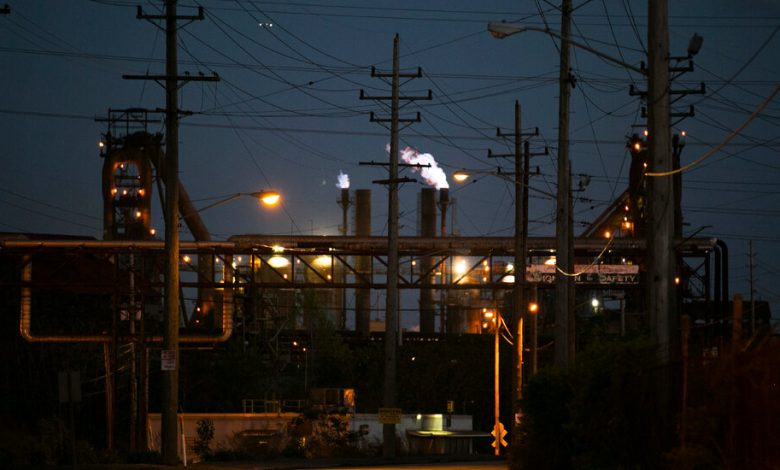Polluting Industries Say the Cost of Cleaner Air Is Too High

The U.S. Environmental Protection Agency is about to announce new regulations governing soot — the particles that trucks, farms, factories, wildfires, power plants and dusty roads generate. By law, the agency isn’t supposed to consider the impact on polluting industries. In practice, it does — and those industries are warning of dire economic consequences.
Under the Clean Air Act, every five years the E.P.A. re-examines the science around several harmful pollutants. Fine particulate matter is extremely dangerous when it percolates into human lungs, and the law has driven a vast decline in concentrations in areas like Los Angeles and the Ohio Valley.
But technically there is no safe level of particulate matter, and ever-spreading wildfire smoke driven by a changing climate and decades of forest mismanagement has reversed recent progress. The Biden administration decided to short-circuit the review cycle after the E.P.A. in the Trump administration concluded that no change was needed. As the decision nears, business groups are ramping up resistance.
Last month, a coalition of major industries, including mining, oil and gas, manufacturing, and timber, sent a letter to the White House chief of staff, Jeffrey D. Zients, warning that “no room would be left for new economic development” in many areas if the E.P.A. went ahead with a standard as tough as it was contemplating, endangering the manufacturing recovery that President Biden had pushed with laws funding climate action and infrastructure investment.
Twenty years ago, generating electric power caused far higher soot emissions, so “there was room” to tighten air quality standards, said Chad Whiteman, vice president of environment and regulatory affairs at the Chamber of Commerce’s Global Energy Institute, in an interview. “Now we’re down to the point where the costs are extremely high,” he said, “and you start bumping into unintended consequences.”
Research shows that in the first decades after the passage of the Clean Air Act in 1967, the rules lowered output and employment, as well as productivity, in pollution-intensive industries. That’s why the cost of those rules has often drawn industry protests. This time, steel and aluminum producers have voiced particularly strong objections, with one company predicting that a tighter standard would “greatly diminish the possibility” that it could restart a smelter in Kentucky that it idled in 2022 because of high energy prices.
New factories, however, tend to have much more effective pollution control systems. That’s especially true for two advanced manufacturing industries that the Biden administration has specifically encouraged: semiconductors and solar panel manufacturing. Trade associations for those industries said by email that a lower standard for particulate matter wasn’t a significant concern.
Regardless, public health advocates argue that the averted deaths, illnesses and lost productivity that air pollution caused far outweigh the cost. The E.P.A. pegs the potential benefits at as much as $55 billion by 2032 if it drops the limit to nine micrograms per cubic meter, from the current 12 micrograms. That is far more than the $500 million it estimates the proposal would cost in 2032.
So how are communities weighing the potential trade-offs?
On a state level, it depends to a large degree on politics: Seventeen Democratic attorneys general wrote a joint comment letter in support of stricter rules, while 17 Republican attorneys general wrote one in favor of the status quo.
But it also depends on the mix of industries prevalent in a local area. Ohio offers an illuminating contrast.
Take Columbus, a longstanding hub of headquarters for consumer brands that in recent years has leaned more into professional services like banking and insurance. The Mid-Ohio Regional Planning Commission, a coalition of metropolitan-area governments, called for the E.P.A. to impose the nine-microgram standard.
“There may be some economic costs to major polluting industries, but there’s real health and environmental costs if we do nothing,” said Brandi Whetstone, a sustainability officer at the commission.
Columbus would incur fewer costs from tighter regulation, having enjoyed strong job growth in recent years driven by white-collar industries. But local leaders also think that clean air is a competitive advantage, with the power to draw both new residents and new businesses that value it.
Jim Schimmer is the director of economic development for Franklin County, which includes Columbus. He has been pushing a plan to turn an old airport the county owns into a low-emissions, power-generating transportation and logistics hub, complete with solar arrays and electrified short-haul trucks, and he thinks stronger rules on particulate matter could help.
“This is such a great opportunity for us,” Mr. Schimmer said.
The Cleveland area is a different story, with a high concentration of steel, chemical, aviation and machinery production. Its regional planning council declined to comment on the prospect of stricter air quality rules. Chris Ronayne, the Democratic executive of Cuyahoga County, was cautious in discussing the subject, emphasizing the need for financial assistance to help companies upgrade to lower their emissions.
“I think there is an attitude of ‘work with us, with carrot approaches, not just the big stick,’” Mr. Ronayne said. “Come at us, in a manufacturing town, with both incentives to help us get there as well as the regulation.”
Ohio has an entity to help with that. The Ohio Air Quality Development Authority was created 50 years ago to clean up the brown clouds that came out of smokestacks, using a combination of grants and low-cost revenue bond financing to help businesses fund upgrades like solar panels and scrubbers that filter exhaust from industrial facilities like incinerators and concentrated animal feeding operations.
Now, more funding than ever is available — through the Inflation Reduction Act, which set up a $27 billion “green bank” at the E.P.A. to finance clean energy projects. Christina O’Keeffe, the executive director of the Ohio agency, said she hoped that would allow her to get into direct lending as well when more companies needed her help to meet a stricter air standard. There are also billions in the offing to help heavy industries retrofit to lower their carbon emissions, which tends to help with particulate matter as well.
Public health advocates argue that the E.P.A. should set its standard regardless of the assistance available to cover the cost of compliance.
California, for example, has spent more than $10 billion to help factories and farmers pollute less. The state’s Central Valley is still the only area that is in “serious” violation of meeting the set standard of 12 micrograms per cubic meter of particulate matter. The country’s six most polluted counties, which include the cities of Fresno and Bakersfield, have annual readings above 16 micrograms.
The Central Valley Air Quality Coalition, an advocacy group, has been pushing for more aggressive enforcement for decades. The group’s executive director, Catherine Garoupa, points out that despite the persistent air problems, the federal government has not imposed strict curbs, like holding back highway funding.
“One of the huge imbalances in our region is that the trend has been to cater to industry, treat them with kid gloves, give them billions of dollars in incentive money for them to continue their practices,” Dr. Garoupa said. “They’re generating wealth, but not for the people that actually live in the valley and are breathing the air.”
The San Joaquin Valley Air Pollution Control District, which includes four of the country’s six most polluted counties, has a different take. It filed a comment letter warning of “devastating federal sanctions,” including financial penalties, if the standard was toughened further.
The chair of that air district is Vito Chiesa, a Stanislaus County commissioner who grows walnuts and almonds and used to lead the local farm bureau. His operation has to comply with any limitations on agriculture that might be imposed, like the prohibition on open-air burning of farm waste that the air district adopted after years of demands from public health advocates. He fears that further curbs without adequate support for smaller farmers would jeopardize his employees’ jobs.
“I have like 15 employees out here, and I feel completely responsible for their families,” Mr. Chiesa said. “So how is it going to affect them? Our charge here on the air board is not to do death by a thousand cuts.”
One point of agreement between proponents and many foes of a stronger standard: If the E.P.A. moves forward with tougher rules, it should also crack down on pollution sources, including railroads, ships and airplanes, under its sole jurisdiction. (The agency has proposed a stronger standard for heavy-duty trucks, around which a similar fight is playing out.)
Rebecca Maurer is a City Council member representing a Cleveland neighborhood that has some of the area’s worst pollution. Her office frequently hears from constituents seeking help with housing that is safer for children with asthma, which occurs at alarming rates. The district encompasses an industrial cluster that includes two steel plants, an asphalt plant, a recycling depot, rail yards and assorted small factories.
That’s the most visible source of emissions, but Ms. Maurer thinks her district’s many highways — and the diesel-powered trucks driving on them — offer the greatest opportunity for cleaning up the air, which requires state and federal action. And light manufacturing jobs are needed to employ the two-thirds of the county’s residents who lack college degrees, she said.
“What we don’t want is another asphalt plant, and we don’t want e-commerce,” Ms. Maurer said. “We want something in between. We’re trying to thread this needle between these hugely polluting plants and low density, low-wage warehouse jobs.”




